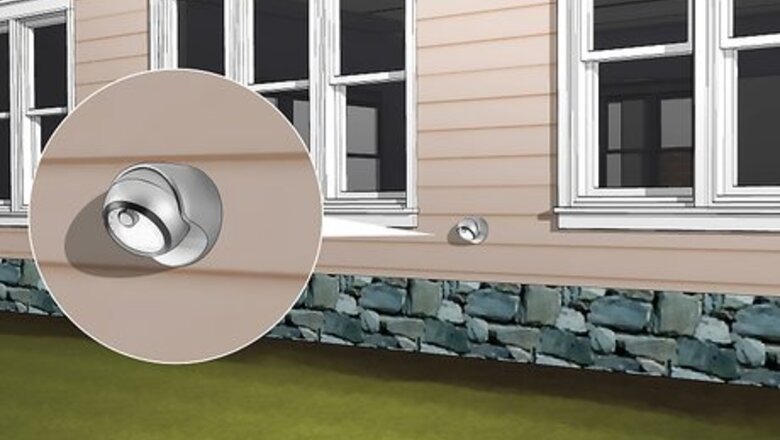
views
- Scare possums away by putting motion-activated lights or sprinklers in your yard. Alternatively, spread repellents, like ammonia, garlic cloves, or chemical sprays.
- Get rid of food sources by securing the lids on your trash cans, feeding pets indoors, and picking up fruit that falls onto the ground from trees or bushes.
- Catch possums with a live-holding cage trap. Release the possum after fixing the damage they caused, or relocate them to a new area if your city allows it.
Scaring Possums Away
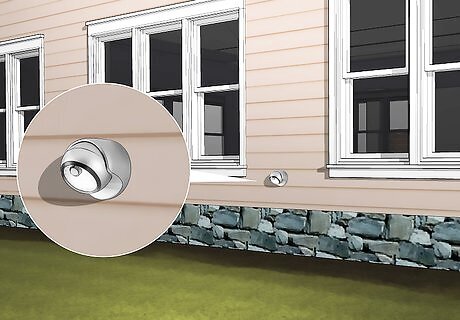
Set up motion-activated lights or sprinklers. Place a motion-activated device near the perimeter of your house, at the front of your property, around fruit trees, or in any other spots where you’ve seen possums. When a possum walks past one of the devices, the lights or sprinklers will turn on and frighten the animal so it won't want to come around again. Motion-activated sprinklers tend to be slightly more effective than motion-activated lights. Lights are enough to frighten away skittish possums that try to stay hidden in the dark, but water sprinklers work better with possums that are more mature and harder to startle. Lights and sprinklers are usually temporary solutions since possums will eventually get used to them.

Scatter tufts of dog or cat fur in areas that possums frequent. After you brush a pet dog or cat, collect all of the pet hair rather than throwing it away. Secure the hair in small mesh bags, and hang or scatter them around your property where you’ve seen possums feeding or hiding. Opossums will smell the fur and think there’s a potential predator in the area, so they may find a new place to call home instead of your yard.Note: Avoid letting your dog or cat roam free through the yard to try scaring possums away. While possums usually aren’t aggressive, they could still carry ticks, fleas, or bacterial infections.
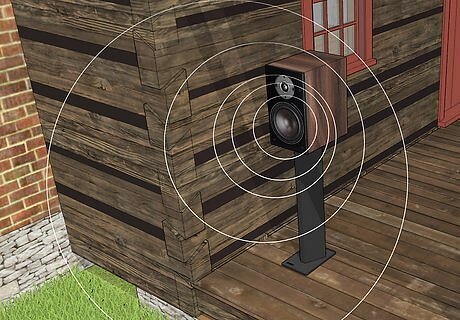
Play a radio continuously where possums take shelter. If you suspect there’s an opossum living under a porch or in a shed, set a radio to a low volume and place it nearby. The constant noise from the radio will make the possum think there are people nearby and will encourage them to find a quieter place to build their dens. Make sure the radio isn’t so loud that it disrupts you or your neighbors. A low or moderate volume will be enough to scare the possums away.
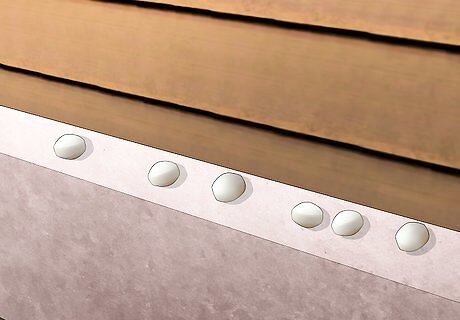
Keep strong-smelling repellents near problem areas. Possums have a strong sense of smell, and products like ammonia, garlic cloves, and bleach are all really unpleasant to them. If you’re using ammonia or bleach, mix 1 part of the repellent with 10 parts water into a coffee can with a lid. Place a rag in the mixture and create a "wick" by bringing one end of the rag through a hole cut into the lid. If you’re using garlic, crush the cloves to make them more pungent. Set the repellents in areas where you’ve seen possums, and replace them every few days. Scent repellents are typically temporary solutions because possums will eventually get used to the odors.
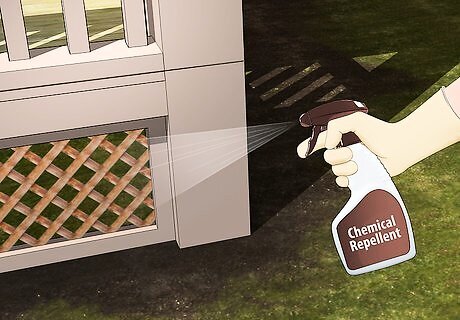
Apply a chemical repellent. Chemical repellents usually have ingredients like naphthalene crystals or predator urine that are unpleasant for possums. Follow the instructions on the specific repellent you’re using. Typically, you’ll apply the repellent spray or powder to gardens, flowerbeds, or around the perimeter of your home. You may need to reapply the repellents every few weeks as the odors become less potent to keep possums away.
Removing Access to Food
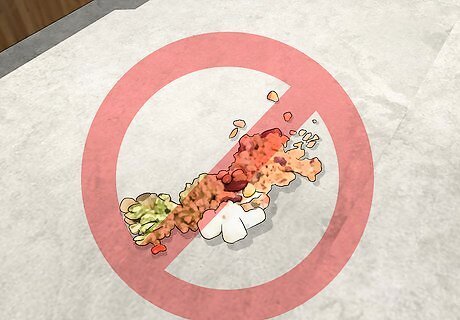
Avoid intentionally feeding possums in your yard. Possums are attracted to yards and homes where food is plentiful, so leaving out scraps or pet food will make them keep coming back. If you’ve already been feeding possums, stop putting out food for them so they stop visiting your property. While possums are usually non-confrontational, feeding them may make them gradually lose their fear of humans and make them more aggressive when food is not given to them. Possums don’t carry the rabies virus, but they may spread bacterial infections like tuberculosis, relapsing fever, or Chagas disease. They may also carry fleas, ticks, or lice onto your property. EXPERT TIP Kevin Carrillo Kevin Carrillo MMPC, Pest Control Specialist Kevin Carrillo is a Pest Control Specialist and the Senior Project Manager for MMPC, a pest control service and certified Minority-owned Business Enterprise (MBE) based in the New York City area. MMPC is certified by the industry’s leading codes and practices, including the National Pest Management Association (NPMA), QualityPro, GreenPro, and The New York Pest Management Association (NYPMA). MMPC's work has been featured in CNN, NPR, and ABC News. Kevin Carrillo Kevin Carrillo MMPC, Pest Control Specialist Our Expert Agrees: Most pests are looking for a safe place to eat that also has an abundant food source. If you're leaving food out for other animals like stray cats, it's more likely that possums are eating the food. Eliminate the food sources to remove your possum problem.
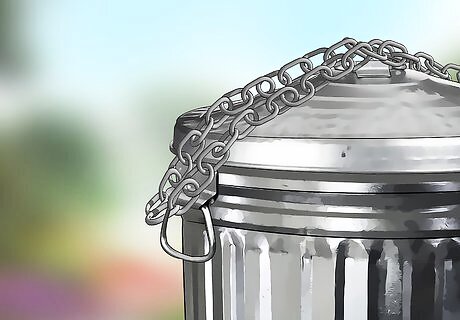
Keep lids securely on your trash can. To prevent possums from finding food scraps in your garbage, secure the can’s lid with bungee cords, chains, ropes, or weights. Alternatively, use a garbage can that has clips on the lid so it doesn’t easily come undone. Some opossums may try knocking over a trash can to access the food inside. Drive stakes through the handles of the garbage can and into the ground to secure them in place.

Feed your pets indoors. Even if your pets eat their food rapidly, the smell of the food residue left in the bowl may lure possums to your yard. Bring your pet and their food inside during mealtimes so they can finish their meal. If you’re not able to feed your pets inside, feed your pets outdoors in the late morning or middle of the afternoon. That way, the food is not around when dusk settles in and the possums are most active. Avoid keeping food near a pet door that leads outside since possums may be able to smell it and try to get inside your home.This includes feeding animals you keep outside, such as chickens. Possums are often attracted to chicken feed and could potentially kill your chickens if they get into the coop. If possible, feed your chickens midday when possums are the least active.

Remove or secure any other sources of food. Possums will scavenge for food wherever they can find it on your property, so check your yard for other potential sources. Some common areas where possums may search for food include: Barbecue grills: Clean grills and grease traps after each time you use them. Fruiting plants: Pick up fruit that’s fallen off of trees or bushes. Compost piles: Use covered compost bins rather than open containers or loose piles. Birdseed: Only spread as much feed as birds will eat for a single day while the sun is out. Alternatively, fill bird feeders with seeds and hang them high in the air where possums can’t reach them.
Trapping and Removing Possums

Get a live-holding cage trap. Live-holding traps capture possums without hurting or killing them, and they’re preferable to quick-kill traps. Choose a cage trap that’s at least 10 by 12 by 32 inches (25 × 30 × 81 cm) to ensure the largest possums will fit inside. Using quick-kill traps to get rid of possums is restricted or prohibited in many cities. Contact your city’s department of natural resources or local pest control to see if there are any restrictions on trapping possums. Some cities may require you to obtain a permit as well.

Set and bait the trap in the possum's path. Place the trap near suspected possum dens or entry points you found near your home. Otherwise, place the trap flush with a wall near a fence or your home. Each cage trap is set in a slightly different manner, so follow the manufacturer’s instructions to rig it properly. Set bait inside—fruit, berries, vegetables, raw eggs, peanut butter, and sardines are attractive options for possums. Most traps have a trigger rod or knob that must be pulled or twisted out when you open the door of the cage. Set the trap on soft ground or place it on plywood if setting it on a hard surface. The trapped possum may attempt to dig its way out, and placing the trap on a protective surface will prevent it from damaging its paws. Set the trap at dusk to increase your odds of catching possums, which are nocturnal animals.

Check the trap every morning and evening. Because opossums are nocturnal, they’ll usually go into the trap when they’re active at dusk or throughout the night. Be sure to check your trap twice a day so you can take care of a possum as soon as you capture it. Once you find a possum in the trap, cover it with a tarp so the animal isn’t as frightened. Possums may hiss or growl at you as you get closer, or they may play dead so you leave them alone. While possums aren’t typically aggressive, put on thick gloves before handling the trap to prevent yourself from getting scratched through the cage. Avoid checking the trap more frequently because your presence around the trap may deter possums from approaching.
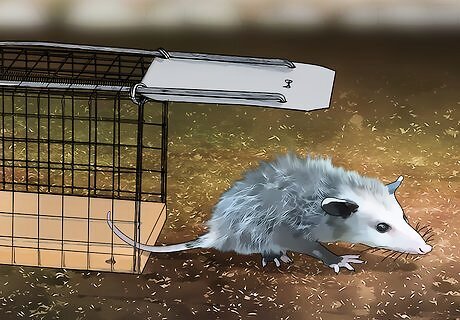
Relocate and release the animal from the trap. Check with your city’s pest control services or department of natural resources to find out what restrictions there are about releasing or relocating the possum. You may be able to move the possum to a new location, or you may have to release it in the same area after fixing any damage they caused. When you’re releasing the possum, point the trap’s opening in the direction you want the animal to run off. Stand at the opposite end of the door after you open it, and tap the trap with your foot or a long pole until the animal runs out. Trapped animals often lash out in fear, and you may be scratched or bitten if you are not careful. Stand back from the cage so the possum has some space and doesn’t feel as threatened. Some cities may require that you hire a professional to relocate or release the possum.
Keeping Possums Out of Your Home
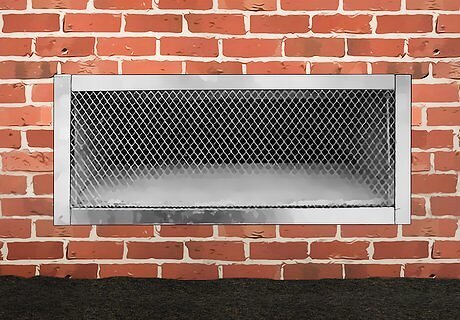
Cover your foundation vents. Possums can easily access your home through the dryer vent or other air vents along your home’s foundation. Install a slotted metal cover over the vents along the perimeter of your home to block possums from sneaking in. These covers are screwed onto the vent and have just enough room for steam and smoke to escape but not enough for possums to sneak through. Make sure there aren’t any possums already inside your home before installing a vent cover. Sprinkle flour outside of the vent and check in the evening for tracks leading away from the vent.
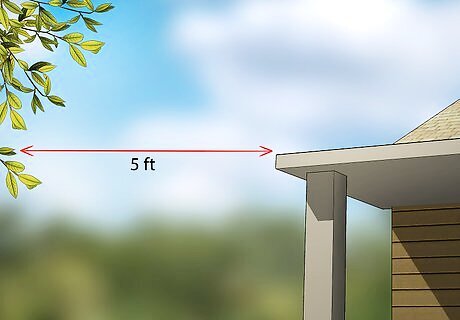
Trim tree branches 5 ft (1.5 m) from your roof. Possums can sneak onto your roof if tree branches or other tall plants are positioned nearby. Cut away branches and shrubbery that overhang your roof so possums don’t have an access point through your attic or chimney. Avoid growing climbing plants near or on your home, especially near the eaves or downspouts. You may also try installing bird control spikes along rain gutters to prevent possums from climbing on them.
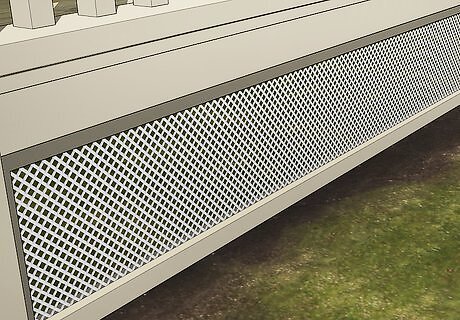
Install hardware cloth below decks or raised porches. Use hardware cloth that has a ⁄4 in (6.4 mm) grid screening, or install solid metal flashing around the base of your deck. First, dig a trench that’s 12 in (30 cm) deep around the perimeter of the deck. Place the screening or flashing in the trench so it extends from the bottom of the trench to the underside of the deck. Then, fill the trench with dirt and secure the top of the screening to the deck with nails or staples. Possums often hide out during the day underneath decks, so a barrier will make them find another place to go during the day.
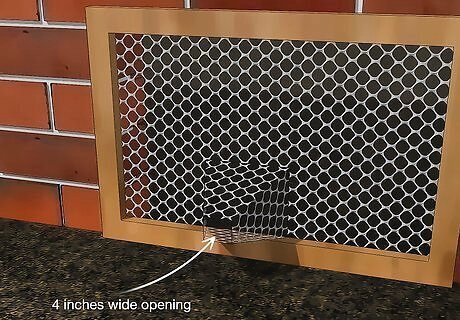
Create a temporary one-way exit for any trapped possums. If you suspect possums are inside or stuck underneath a deck, avoid sealing the area completely. Form ⁄4 in (6.4 mm) grid screening into a cone or funnel. Set the large end of the cone against the entry hole so the possum can get out. Shape the hole at the small end of the screen so it’s 4 inches (10 cm) in diameter, which prevents the possum from getting back inside. Secure the screen to the entryway with nails or staples. Keep the passage open for a few days or up to one week before sealing up the hole to ensure any possums inside have left.

Seal any other open spaces on your home’s exterior. Your home may have other open spaces that are inviting to a possum, such as attic vents or chimneys. Cover the openings with ⁄4 in (0.64 cm) grid screening and secure them in place with nails or staples. Install a chimney cap to cover the large opening on the top of your chimney while still letting smoke and fumes escape. Check for any holes in deck lattices, window screens, or door screens, and be sure to repair them as well. If you have a pet door leading outside, lock or cover it at night so possums can’t find their way inside. Possums may also make their homes under loose wood piles, so ensure firewood is stacked and organized.
Identifying a Possum Infestation
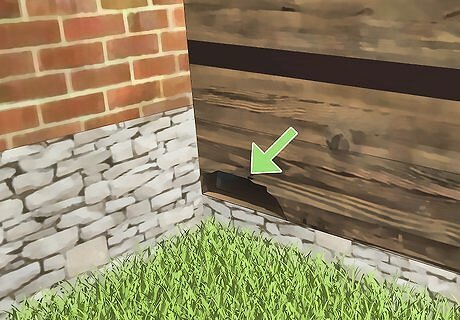
Search for large entry holes around your property. Possums will look for a dark, quiet place to hide or build their den during the day, so they may get underneath a deck, inside of a shed, or into a vent or hole in the side of your home. They may make large holes, tear through insulation, or chew through wires and water lines. Entry points for possums are usually larger than 6 inches (15 cm), but they may enlarge smaller holes to get inside. If you’re unsure of a possum living on your property, sprinkle a layer of flour around the entryway. In the evening, check the flour for any tracks. If you don’t see any tracks within 3 days, then there are no possums.
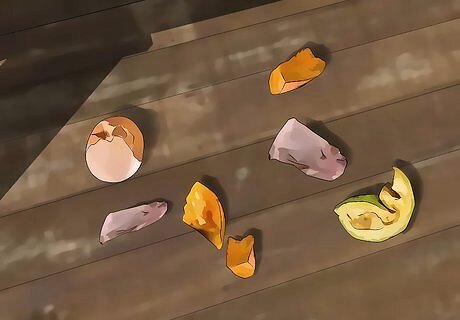
Check for food remnants from foraging possums. Possums are messy eaters, so they usually leave scraps of food behind. Check near your garden, trash cans, or any pet food bowls that you left outside to see if they’ve been rummaged through.
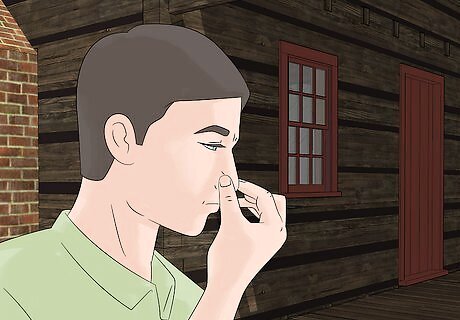
Identify smelly areas around nesting sites. When possums build their nests, they secret a smelly discharge that may be slightly similar to a skunk’s scent. If you suddenly notice an offensive odor near an outdoor deck or in a shed, then it may be a sign that opossums are living in the area. If you smell a rotting odor, it could be a sign that a possum has died and is stuck in a hard-to-reach area.
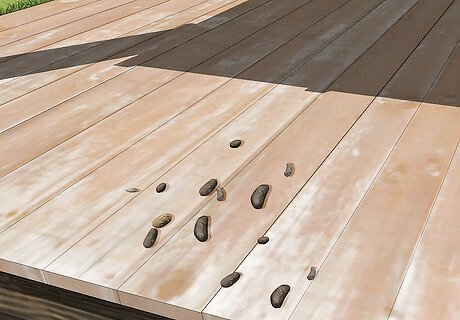
Look for possum tracks or droppings. Keep your eye out for prints that have 5 fingers and are about 2 inches (5.1 cm) in diameter. The hind tracks are slightly larger and have one toe sticking out in a different direction than the others. You may also notice a line where the possum drags its tail. Keep your eyes out for droppings that are 1–3 in (2.5–7.6 cm) long and have pointed ends. Droppings alone may be hard to distinguish since possums are omnivores and the dropping appearance varies depending on what the animal ate.















Comments
0 comment